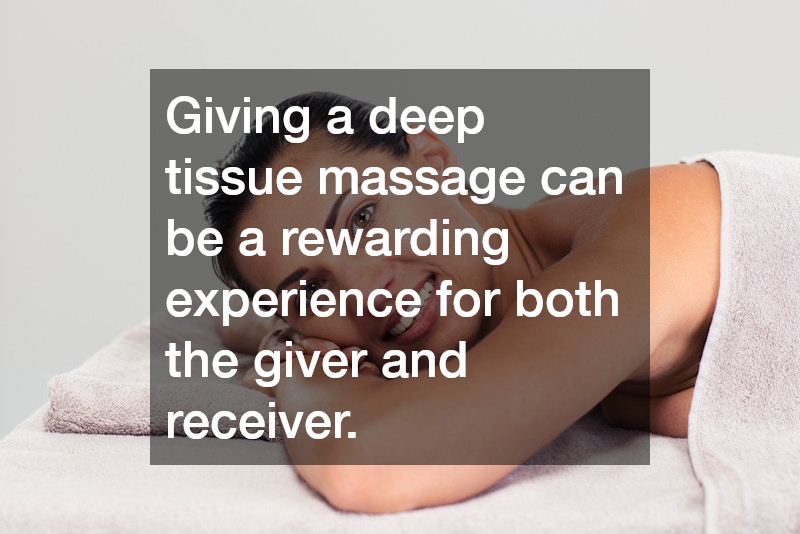Deep tissue massage is a therapeutic technique designed to alleviate tension in deeper layers of muscle and connective tissue. This type of massage can provide relief from chronic pain, enhance athletic performance, and improve overall well-being. If you’re interested in learning how to give a deep tissue massage, this guide will walk you through the essentials, including preparation, techniques, and aftercare.
Understanding Deep Tissue Massage
Before diving into the how-to, it’s essential to understand what deep tissue massage entails. Unlike a typical Swedish massage, which focuses on relaxation and surface muscles, deep tissue massage aims to address chronic tension and pain.
It uses slow strokes and deep pressure to target the underlying layers of muscles and fascia. This can help break down adhesions (knots) and relieve stiffness.
Preparation
1. Create a Comfortable Environment
The first step to giving a great deep tissue massage is creating a relaxing atmosphere. Choose a quiet space with minimal distractions. Dim the lights and play soft, calming music if desired. Ensure the room is warm and comfortable, as relaxation can be disrupted by a chilly environment.
2. Gather Your Supplies
You’ll need a few essential items:
- Massage Table or Firm Surface: A massage table is ideal, but a firm bed or mat can work too.
- Towels: Use towels to cover areas of the body not being massaged and to provide comfort.
- Oil or Lotion: A massage oil or lotion will help reduce friction on the skin. Look for options that are unscented or lightly scented to enhance relaxation.
3. Prepare Yourself
Make sure you’re in a good mental and physical state before beginning the massage. Wash your hands and trim your nails to avoid discomfort. You should also be mindful of your own body mechanics; maintaining proper posture will help prevent strain on your back and hands.
Techniques for Deep Tissue Massage
Now that you’re prepared, here are some key techniques to incorporate into your deep tissue massage:
1. Effleurage
Start with gentle effleurage strokes to warm up the muscles. Use your palms to glide smoothly over the skin, applying light pressure. This helps the recipient relax and prepares their body for deeper work. Spend about 5-10 minutes on this initial phase, focusing on the major muscle groups like the back, shoulders, and thighs.
2. Petrissage
After warming the muscles, transition to petrissage techniques. This involves kneading the muscles, using your thumbs, fingers, and palms to lift, roll, and squeeze the tissue. Focus on areas of tightness, working in small circular motions. This technique helps to increase circulation and relieve muscle tension.
3. Friction
Friction involves applying deeper pressure to specific areas. Use your thumbs or fingers to apply concentrated pressure on knots or adhesions. This technique can be uncomfortable, but it should not cause pain. Communicate with your recipient and adjust your pressure as needed.
4. Stripping
Stripping is a technique where you apply deep, long strokes along the muscle fibers. Use your forearms, palms, or thumbs to glide along the length of the muscle. This technique can help break down tension and improve flexibility.
5. Cross-Fiber Friction
For specific knots, use cross-fiber friction. This technique involves applying pressure perpendicular to the muscle fibers. It can be particularly effective for areas of chronic tension, such as the shoulders and neck.
6. Stretching
Incorporate gentle stretching to enhance the benefits of the massage. While holding a muscle, gently stretch it while maintaining pressure. This helps release tension and improve flexibility.
Aftercare
Once the massage is complete, the aftercare process is vital for recovery and relaxation.
1. Allow Time to Relax
Encourage the recipient to take a few moments to relax after the massage. This time allows their body to integrate the benefits of the massage. Provide a warm towel or blanket for added comfort.
2. Hydration
Remind them to drink plenty of water post-massage. Hydration helps flush out toxins released during the massage and aids muscle recovery.
3. Feedback
Ask for feedback on the massage. This not only shows you care but also helps you improve your technique for future sessions. Discuss any areas that were particularly tense or any discomfort experienced during the massage.
Conclusion
Giving a deep tissue massage can be a rewarding experience for both the giver and receiver. By creating a comfortable environment, using appropriate techniques, and fostering open communication, you can provide a therapeutic experience that alleviates tension and promotes relaxation. Remember, practice makes perfect, so don’t hesitate to refine your skills and adapt your techniques based on the individual needs of the recipient. Whether you’re massaging a friend, family member, or a professional client, your efforts can significantly enhance their well-being.
.





